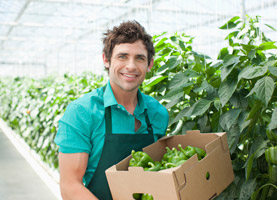Growing Organic Produce Packed with Essential Nutrients
Download Audio VersionThere are many arguments in favor of organic fruits and vegetables, and the main ones are more nutrients and fewer herbicides and pesticides. A study conducted by researchers at Newcastle University reveals that organic crops contain up to 40 percent higher levels of iron, zinc, vitamin C, and other essential nutrients compared to conventionally grown fruits and vegetables.
Growing Fruits and Vegetables
The first step to growing organic produce at home is to build up the soil. A healthy, rich soil facilitates the growth of deep roots that absorb more water and nutrients. You can add compost to the soil to improve its structure and composition. Another way to increase your yields is to make raised beds by using deep-layer soil. Spacing is also important. It is better to plant in triangles rather than rows or patterns. You can increase your yields by going vertical. Use stakes, cages, or fences to grow melons, squash, peas, pole beans, tomatoes, and other crops. This way, you will see where the fruits and vegetables are. Crops that are grown vertically are at a lower risk of fungal diseases and harmful bacteria. When growing tomatoes, vines, or melons, you may use string and mesh netting attached to end posts.
Types of Organic Fertilizers

As a rule, organic fertilizers are free of harmful chemicals and are derived from plant and animal matter. Examples include guano, seaweed, peat, and warm castings. Organic fertilizers also come in the form of slurry, manure, compost, and humic acid. While some farmers use sewage sludge, it contains heavy metals and is prohibited in some countries. Fertilizers serve as natural conditioners that improve soil structure and feed the plants. The main difference between organic and chemical fertilizers is that the latter contain mineral salts. They are absorbed by plants and are acidic meaning that they are not a good food source for bacteria and other microorganisms. The structure of soil that is treated with chemical fertilizers declines with time. Larger amounts of synthetic chemicals are required to achieve the same crop yields.
What is more, the production of chemical fertilizers requires natural gas, coal, and other non-renewable resources. Acids are also used to make minerals in rocks more soluble. Check labels before buying and avoid products that contain nitrogen-phosphorus-potassium. Opt for products that read “low analysis” and “slow release”. The best thing about organic fertilizers is that they are as effective as synthetic ones. Liquid seaweed, manure pellets, and other products can be used for houseplants as well.
Improving Soil Quality
You may also want to get your soil tested. Nurseries, garden centers, and cooperative extensions offer testing. You will find out whether your soil lacks certain minerals and nutrients. This way you can improve its structure. For example, if your soil is sandy, you can add compost that is rich in minerals such as iron, zinc, carbon, and others. Clay soil has a good water-holding capacity. The problem is that it is alkaline and takes a long time to drain. Again, you can add organic matter and fertilizers to improve its quality. You can use compost, manure, shredded leaves, grass clippings, and so on.
Choice of Location
The terrain and whether the land slopes are important considerations. In case there is a depression, you may want to use soil to fill it up or otherwise water will collect there. Rotted roots are often the result of soggy soil. Obviously, you want to choose a location that gets direct sunlight for about 8 hours. Some crops prefer shady sites while others need plenty of sunlight. Wind is another factor for homeowners that live in windy areas. You may want to place a wall or hedge next to your garden to minimize wind exposure. It will serve as a windbreak. When choosing a location for your garden, consider things such as access to compost (if used), tools like hoes and spades, and water and other utilities. If you choose a location that is not convenient, you will end up dragging tools which is a waste of efforts and time.
Related Articles
Green School Lunches to Reduce Waste
Schools of average size produce over 20 tons of waste annually. In fact, research studies in the US show that school waste accounts for close to 24 percent of the total waste Fruits, vegetables, and salads are wasted the most. Young kids produce more waste than older students. Reasons for Food...
Eco-Friendly Celebrations for Nature Lovers
There are many ways to make your dinner or party an eco-friendly one. Whether it is a birthday party, anniversary, or getting together with family or friends, there are ways to green your celebration. Greening Your Dinner PartyYou can use Evite or another service to send online invitations instead...
Eco Groceries Are Nutritious and Minimize Pollution
Eco groceries are vegetables, fruits, and other products that are produced locally and reduce the amount of carbon emissions released into the atmosphere. There are different ways to buy green groceries, including local farmers’ markets, food co-ops, and specialty grocery stores. Alternatively, you...


